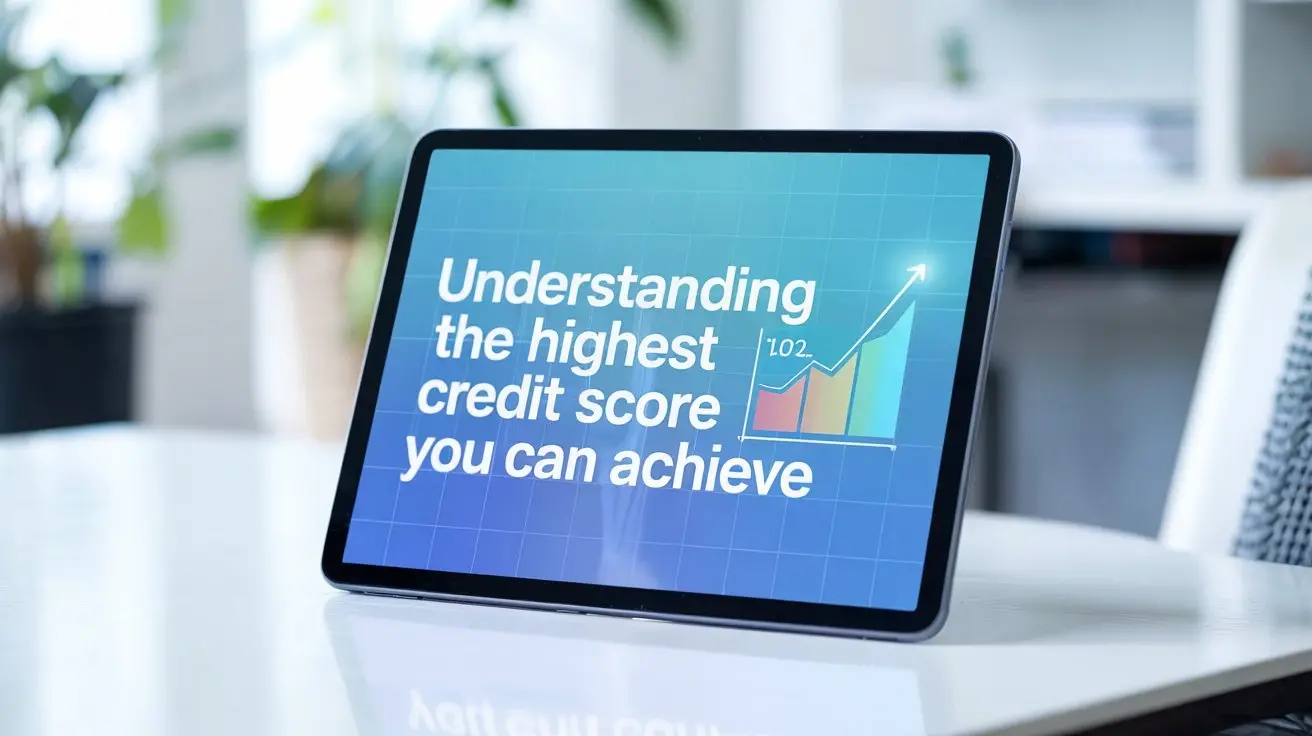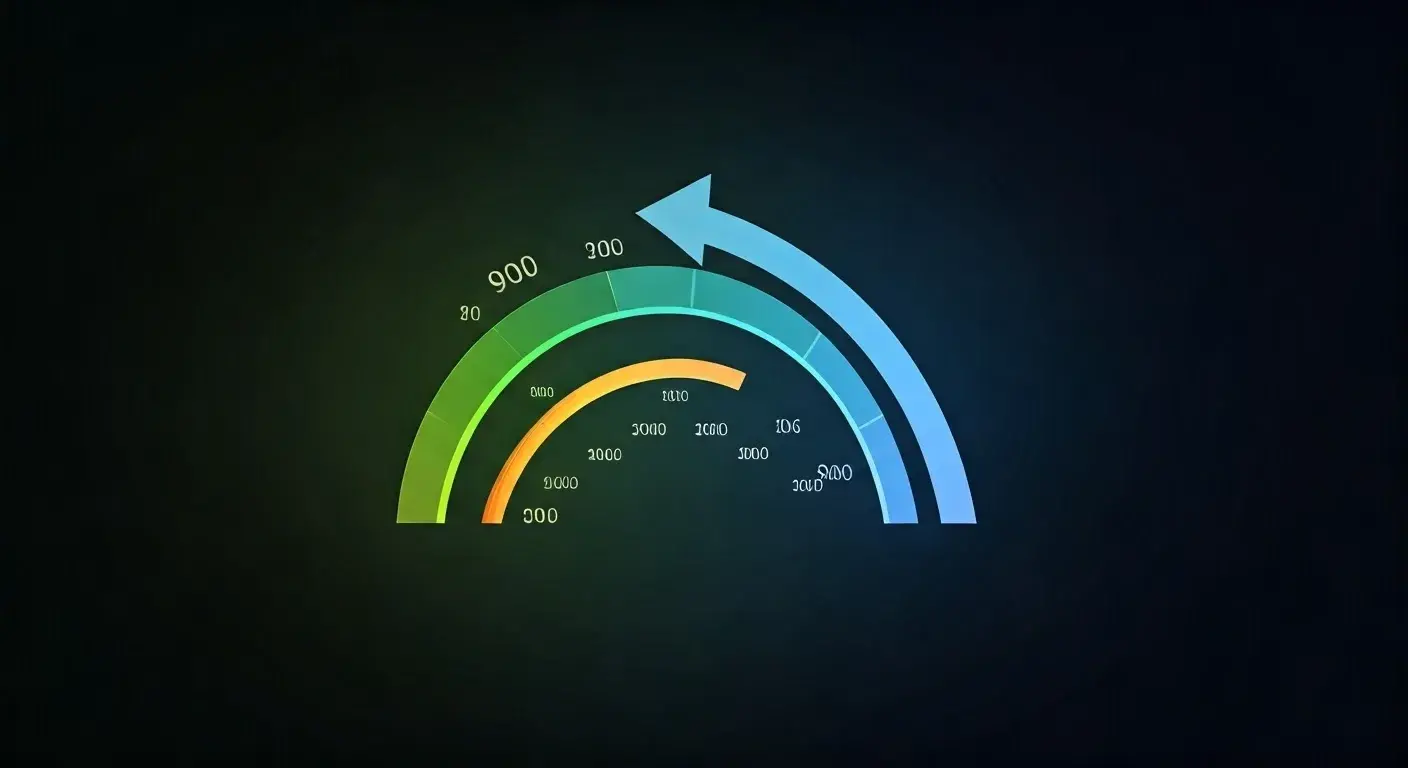-
Posted on: 21 Dec 2022

-
Understanding your credit score is crucial for navigating modern financial life. This guide demystifies credit scores, explaining what they are, how they're calculated, and why they matter for loans, housing, and even employment. Empower yourself with knowledge to build and maintain a strong credit profile.
What is a Credit Score?
A credit score is a three-digit number that lenders use to assess your creditworthiness, or how likely you are to repay borrowed money. Think of it as a financial report card. It’s a snapshot of your credit history, compiled from information reported by your creditors to credit bureaus. In 2025, this number remains a cornerstone of financial decision-making for institutions ranging from banks and credit card companies to landlords and even some employers.
The most common credit scoring models are FICO and VantageScore. While they use similar factors, their exact algorithms and score ranges can differ slightly. However, the fundamental purpose remains the same: to predict the probability that you will default on a loan within a specific timeframe. A higher score generally indicates lower risk, making it easier and cheaper to borrow money.
Why Your Credit Score Matters
Your credit score is more than just a number; it's a powerful tool that significantly influences your financial life. In 2025, a good credit score can open doors to numerous opportunities, while a poor one can create substantial obstacles. Understanding its impact is the first step toward achieving your financial goals.
Access to Credit and Loans
The most direct impact of your credit score is on your ability to obtain credit. Lenders, including banks, credit unions, and online lenders, use your score to decide whether to approve your applications for:
- Credit cards
- Mortgages (home loans)
- Auto loans
- Personal loans
- Student loans
A higher score means you're more likely to be approved. Furthermore, it often translates to better terms, such as lower interest rates. For instance, a borrower with a score of 780 might secure a mortgage at a 5.5% interest rate, while a borrower with a score of 650 might face a rate of 7.5% or higher. Over the life of a 30-year mortgage, this difference can amount to tens of thousands of dollars in saved interest.
Interest Rates
As mentioned, your credit score is a primary determinant of the interest rates you'll be offered. This applies not just to loans but also to credit cards. A strong credit score can save you substantial money over time by securing lower Annual Percentage Rates (APRs). Conversely, a low score can lead to significantly higher borrowing costs, making debt more expensive and harder to manage.
Renting an Apartment
Landlords often check credit scores as part of their tenant screening process. A good score suggests you are responsible and likely to pay your rent on time. A low score might result in a denied rental application, a requirement for a larger security deposit, or a co-signer.
Insurance Premiums
In many states, insurance companies use credit-based insurance scores to help determine premiums for auto and homeowners insurance. While not directly tied to your credit score, the underlying data is similar. Individuals with better credit histories often pay lower insurance premiums because data suggests they are less likely to file claims.
Employment Opportunities
Some employers, particularly in industries involving financial responsibility or handling sensitive information, may review a candidate's credit report as part of a background check. While they cannot see your actual credit score, they can see your credit history. A history of defaults, bankruptcies, or excessive debt could be a red flag.
Utility Services and Cell Phone Plans
Utility companies (electricity, gas, water) and cell phone providers may also check your credit history. If you have a low credit score or no credit history, you might be required to pay a security deposit to establish service.
Negotiating Power
A strong credit score gives you leverage. When you're looking for a loan or a credit card, you can often shop around and compare offers from multiple lenders, confident that you'll be approved. This allows you to negotiate for the best possible terms and interest rates.
How Credit Scores Are Calculated
Understanding the mechanics behind your credit score is key to improving it. While the exact formulas are proprietary secrets of FICO and VantageScore, the general factors they consider are well-documented. These factors are weighted differently, meaning some have a greater impact on your score than others. In 2025, these core components remain consistent.
Payment History (Approximately 35% of FICO Score)
This is the most critical factor. It reflects whether you pay your bills on time. Late payments, missed payments, defaults, bankruptcies, and collections can significantly damage your score. Even a single 30-day late payment can have a negative impact, and the longer a payment is overdue, the more severe the consequence.
Amounts Owed / Credit Utilization (Approximately 30% of FICO Score)
This factor looks at how much credit you are using compared to your total available credit. It's often expressed as a credit utilization ratio. For example, if you have a credit card with a $10,000 limit and you owe $3,000 on it, your utilization ratio is 30%. Keeping this ratio low, ideally below 30% and even better below 10%, is crucial. High utilization suggests you might be overextended and at a higher risk of defaulting.
Length of Credit History (Approximately 15% of FICO Score)
This factor considers how long your credit accounts have been open and the average age of your accounts. A longer credit history generally indicates more experience managing credit responsibly. Closing older accounts, especially those with a positive payment history, can shorten your average credit history length and potentially lower your score.
Credit Mix (Approximately 10% of FICO Score)
This refers to the variety of credit you have. Lenders like to see that you can manage different types of credit responsibly, such as revolving credit (credit cards) and installment loans (mortgages, auto loans, personal loans). However, this factor is less important than payment history or credit utilization. You don't need to open new accounts just to diversify your credit mix; it's more about how you manage the credit you already have.
New Credit (Approximately 10% of FICO Score)
This factor considers how many new credit accounts you've opened recently and how many hard inquiries you have on your credit report. Opening several new accounts in a short period can signal increased risk. A hard inquiry occurs when a lender checks your credit as part of an application process. While shopping for a mortgage or auto loan within a short timeframe (e.g., 14-45 days, depending on the scoring model) usually counts as a single inquiry, multiple inquiries for different types of credit can lower your score.
It's important to note that credit scoring models are updated periodically. For example, FICO 10 T and VantageScore 4.0 are current models in 2025, incorporating more advanced analytics, but the core principles remain the same.
Understanding Credit Score Ranges
Credit scores typically fall within a specific range, and where your score lands dictates how lenders perceive your credit risk. While the exact ranges can vary slightly between FICO and VantageScore, the general interpretation remains consistent. In 2025, these ranges are widely accepted:
Score Range Category Description 800-850 Exceptional Excellent credit. You are considered a very low risk to lenders, likely to receive the best terms and lowest interest rates. 740-799 Very Good Strong credit. You are a low-risk borrower and will likely qualify for most loans with favorable terms. 670-739 Good Average credit. You should be able to qualify for most loans, but terms may not be as competitive as those with higher scores. 580-669 Fair Subprime credit. You may face challenges getting approved for loans, and if approved, you'll likely pay higher interest rates. 300-579 Poor Very high risk. It will be difficult to obtain credit, and you'll likely face significant challenges and high costs if approved. Note: The exact cutoffs for these ranges can differ slightly between FICO and VantageScore. For example, VantageScore 4.0 might consider 721-850 as "Excellent," 661-720 as "Good," 601-660 as "Fair," and below 600 as "Poor." However, the overarching principle is that higher scores equate to lower risk and better financial opportunities.
It's crucial to aim for the "Good" to "Exceptional" ranges. Even a score in the "Very Good" category can save you thousands of dollars in interest over the life of a loan. Conversely, a score in the "Fair" or "Poor" category can make obtaining essential financial products incredibly difficult and expensive.
Factors That Impact Your Credit Score
Understanding the components that build your credit score is essential. By focusing on the areas that carry the most weight, you can strategically improve your financial standing. In 2025, these factors continue to be the primary drivers of your creditworthiness.
Positive Factors
- On-time payments: Consistently paying all your bills by their due date is the most significant positive contributor to your credit score.
- Low credit utilization ratio: Keeping your credit card balances low relative to your credit limits demonstrates responsible credit management.
- Long credit history: Maintaining accounts in good standing for many years builds a positive track record.
- Diverse credit mix: Managing different types of credit (e.g., credit cards and installment loans) responsibly can be beneficial.
- Infrequent applications for new credit: Applying for credit only when you genuinely need it minimizes the impact of hard inquiries.
Negative Factors
- Late payments: Missing payment deadlines, especially by 30 days or more, is a major detractor.
- High credit utilization ratio: Carrying high balances on your credit cards signals financial strain and increases risk.
- Maxed-out credit cards: Having balances close to or at the credit limit is a strong negative indicator.
- Defaults and collections: Accounts sent to collections or charged off by the lender severely damage your score.
- Bankruptcy: A bankruptcy filing has a profound negative impact and can remain on your credit report for up to 10 years.
- Foreclosure: Similar to bankruptcy, foreclosure is a serious negative mark.
- Frequent applications for new credit: Applying for multiple credit lines in a short period can suggest desperation or financial instability.
- Errors on your credit report: Inaccurate negative information can unfairly lower your score.
It's important to remember that credit scoring models are designed to predict future behavior based on past actions. Therefore, the most impactful actions are those that directly relate to how you've managed debt and payments in the past.
How Payment History Affects Your Score
Payment history is the bedrock of your credit score, accounting for roughly 35% of your FICO score. This component tracks your diligence in meeting your financial obligations. Every time you make a payment on a loan or credit card, the creditor reports this information to the credit bureaus. The crucial data points are whether the payment was made on time and, if not, how late it was.
Consequences of Late Payments:
- 30 days late: This is the first level of delinquency and can immediately lower your score. While the impact might be less severe than later delinquencies, it's still a negative mark.
- 60 days late: The negative impact escalates significantly.
- 90 days late or more: These are considered severe delinquencies and can drastically reduce your credit score.
- Charge-off: When a creditor deems a debt unlikely to be collected, they may charge it off. This is a serious negative event.
- Collection accounts: If a charged-off account is sent to a collection agency, it further damages your score.
Mitigating Negative Payment History:
- Set up automatic payments: This is one of the most effective ways to ensure you never miss a due date.
- Set reminders: Use calendar alerts or sticky notes if you prefer manual payments.
- Contact creditors: If you anticipate a late payment, reach out to your creditor before the due date to discuss potential arrangements.
How Credit Utilization Affects Your Score
Credit utilization, accounting for about 30% of your FICO score, measures the amount of revolving credit you are using compared to your total available revolving credit. Revolving credit includes credit cards and lines of credit. The ratio is calculated as:
Credit Utilization Ratio = (Total Balances on Revolving Accounts) / (Total Credit Limits on Revolving Accounts) * 100Why Low Utilization is Key:
A low credit utilization ratio indicates that you are not heavily reliant on credit and are managing your available credit responsibly. Lenders see this as a sign of financial stability. For example, if you have two credit cards with limits of $5,000 each (total $10,000 credit limit) and you owe $1,000 on one and $500 on the other (total $1,500 balance), your utilization is 15% ($1,500 / $10,000).
Recommendations for Optimal Utilization:
- Keep it below 30%: This is a widely accepted benchmark.
- Aim for below 10%: For the best scores, keeping your utilization below 10% is ideal.
- Pay down balances before the statement date: Many credit card companies report your balance to the credit bureaus on your statement closing date. Paying down your balance before this date can result in a lower reported utilization.
- Request credit limit increases: If you have a good payment history, asking for a credit limit increase on existing cards can lower your utilization ratio without you spending more.
- Do not close unused credit cards: Closing a card reduces your total available credit, which can increase your utilization ratio even if your spending habits haven't changed.
How Length of Credit History Affects Your Score
The length of your credit history, accounting for about 15% of your FICO score, reflects your experience managing credit over time. This includes:
- Age of your oldest account: The longer your oldest credit account has been open and in good standing, the better.
- Age of your newest account: Newly opened accounts can slightly lower the average age of your credit history.
- Average age of all your accounts: This is a weighted average.
Building a Long Credit History:
The best way to build a long credit history is to start early and manage your accounts responsibly. If you're young and new to credit, consider becoming an authorized user on a parent's well-managed credit card or opening a secured credit card. Avoid closing older accounts, especially those with a positive history, as this can shorten your average credit age.
How Credit Mix and New Credit Affect Your Score
Credit Mix (Approximately 10% of FICO Score):
This factor assesses your ability to manage different types of credit. Lenders want to see that you can handle both revolving credit (like credit cards) and installment loans (like mortgages, auto loans, or personal loans). Having a mix can be beneficial, but it's not as critical as payment history or utilization. You should not open new accounts solely to improve your credit mix; focus on managing the credit you have.
New Credit (Approximately 10% of FICO Score):
This factor considers recent credit activity. Opening multiple new credit accounts in a short period can be a red flag, suggesting you might be in financial distress or taking on too much debt. This also includes hard inquiries, which occur when a lender checks your credit report as part of an application. While a few inquiries over time are normal, a sudden cluster can lower your score. Shopping for a mortgage or auto loan within a specific window (typically 14-45 days, depending on the model) is usually treated as a single inquiry to allow for rate shopping.
Building and Improving Your Credit Score
Whether you're starting from scratch or recovering from past mistakes, building and improving your credit score is achievable with consistent effort. In 2025, the fundamental principles remain the same. Here’s a step-by-step approach:
Step 1: Check Your Credit Reports
Before you can improve your score, you need to know where you stand and identify any errors. You are entitled to a free copy of your credit report from each of the three major credit bureaus (Equifax, Experian, and TransUnion) annually at AnnualCreditReport.com. Review them carefully for inaccuracies, such as incorrect personal information, accounts you don't recognize, or incorrect payment statuses.
Step 2: Dispute Errors
If you find any errors, dispute them immediately with the credit bureau that issued the report. You can usually do this online, by mail, or by phone. Provide any supporting documentation you have. Correcting errors can sometimes lead to an instant score boost.
Step 3: Pay Bills On Time, Every Time
This is the most crucial step. Make it a priority to pay all your bills by their due date. Set up automatic payments or reminders to avoid missing deadlines. Even a single late payment can significantly damage your score.
Step 4: Lower Your Credit Utilization Ratio
If you have credit card balances, focus on paying them down. Aim to keep your utilization ratio below 30%, and ideally below 10%. If you have multiple cards with high balances, prioritize paying down the one with the highest interest rate (the debt avalanche method) or the smallest balance (the debt snowball method) for psychological wins.
Step 5: Avoid Opening Too Many New Accounts
Only apply for credit when you truly need it. Each application can result in a hard inquiry, which can temporarily lower your score. Spreading out applications over time is best.
Step 6: Keep Old Accounts Open
Unless an old account has an annual fee you can't justify, keep it open and in good standing. Closing older accounts can reduce the average age of your credit history and increase your credit utilization ratio, both of which can negatively impact your score.
Step 7: Consider a Secured Credit Card or Credit-Builder Loan
If you have no credit history or a poor credit history, these products are designed to help you build or rebuild. A secured credit card requires a cash deposit that usually becomes your credit limit. A credit-builder loan involves making payments on a small loan that is held by the lender until you've paid it off.
Step 8: Be Patient
Building good credit takes time. There are no quick fixes. Consistent, responsible financial behavior over months and years is what leads to a strong credit score. The positive effects of good habits compound over time.
Example Scenario: Rebuilding Credit
Let's say Sarah had a few late payments and high credit card balances a year ago, resulting in a credit score of 620. She took the following steps:
- She set up automatic payments for all her bills.
- She focused on paying down one credit card with a $3,000 balance, reducing her utilization from 80% to 20% over six months.
- She avoided new credit applications.
After one year of consistent on-time payments and low utilization, Sarah's credit score has improved to 710. This improvement has allowed her to qualify for a car loan with a much lower interest rate.
Common Credit Score Myths Debunked
The world of credit scores is often shrouded in mystery and misinformation. Debunking these common myths can save you from making decisions that could inadvertently harm your credit. In 2025, these myths persist, so it's important to be aware of them.
Myth 1: Checking your own credit score hurts your score.
Fact: This is false. Checking your own credit report and score (often called a "soft inquiry" or "soft pull") does not affect your credit score. You can check your score as often as you like without penalty. It's only when lenders check your credit as part of an application for new credit (a "hard inquiry" or "hard pull") that it can have a minor, temporary impact.
Myth 2: If you don't use credit, you'll have a good score.
Fact: This is incorrect. A credit score is built on your credit history. If you have no credit history, you have no score. Lenders need data to assess your creditworthiness. People with no credit history are often viewed as risky as those with poor credit because there's no evidence of responsible credit management.
Myth 3: Closing old credit card accounts will increase your score.
Fact: Usually, the opposite is true. Closing an old credit card account can lower your average credit history length and decrease your total available credit. Both of these can negatively impact your score, especially if you carry balances on other cards, as your credit utilization ratio will increase.
Myth 4: You need to carry a balance on your credit card to build credit.
Fact: This is a harmful myth. Carrying a balance means you are paying interest, and high balances contribute to a high credit utilization ratio, which can hurt your score. The best practice is to pay your credit card balance in full every month. Responsible credit building comes from paying on time and keeping utilization low, not from paying interest.
Myth 5: Your credit score is the same everywhere.
Fact: While your credit history is generally consistent across the major bureaus (Equifax, Experian, TransUnion), the exact score you receive can vary. This is because different lenders may pull reports from different bureaus, and different scoring models (FICO, VantageScore) use slightly different algorithms and weightings. Also, your score can change daily as new information is added to your reports.
Myth 6: If you pay off a debt in collections, it disappears from your credit report.
Fact: Paying off a debt in collections is a good financial move and can help your score in the long run, but it does not remove the collection account from your report. The negative mark will remain for up to seven years from the date of the original delinquency, though its impact lessens over time.
Credit Reports vs. Credit Scores
It's common to confuse credit reports and credit scores, but they are distinct elements of your creditworthiness. Understanding the difference is crucial for effective credit management. In 2025, this distinction remains fundamental.
Credit Report
A credit report is a detailed record of your credit history. It's like a comprehensive resume of your borrowing and repayment activities. The information contained in a credit report includes:
- Personal Information: Name, address, Social Security number, date of birth, employment history.
- Credit Accounts: A list of all your credit cards, loans (mortgages, auto loans, student loans, personal loans), and other lines of credit. For each account, it shows the creditor, account number (often partially masked), date opened, credit limit or loan amount, current balance, and payment history (including dates of payments and whether they were on time).
- Public Records: Information from public sources, such as bankruptcies, foreclosures, tax liens, and civil judgments.
- Inquiries: A record of who has accessed your credit report. There are two types:
- Hard Inquiries: Occur when you apply for credit. These can slightly lower your score.
- Soft Inquiries: Occur when you check your own credit, or when a potential employer or insurance company reviews your credit for background purposes. These do not affect your score.
Credit reports are maintained by three major credit bureaus: Equifax, Experian, and TransUnion. Each bureau may have slightly different information, as not all creditors report to all three bureaus.
Credit Score
A credit score is a three-digit number derived from the information in your credit report. It's a snapshot that summarizes your credit risk at a particular moment in time. The most common scoring models are FICO and VantageScore. Your credit score is calculated based on specific factors within your credit report, such as payment history, amounts owed, length of credit history, credit mix, and new credit. A higher score indicates a lower risk to lenders, making it easier to get approved for credit and qualify for better interest rates.
Analogy:
Think of your credit report as a book, and your credit score as the summary or grade at the end of the book. The book contains all the details of your financial journey, while the grade gives a quick assessment of your performance.
Why the Distinction Matters:
- Accuracy: Your credit score is only as good as the information in your credit report. If your report contains errors, your score will be inaccurate.
- Improvement: To improve your score, you need to understand what's in your report and address the factors that are negatively impacting it.
- Monitoring: Regularly checking your credit report (for free annually) allows you to spot and correct errors, while checking your credit score (often available for free through credit card companies or financial apps) gives you a quick pulse on your credit health.
How to Check Your Credit Score
Knowing your credit score is essential for managing your financial health. Fortunately, there are several convenient ways to access it in 2025. It's recommended to check your score regularly to monitor its progress and identify any potential issues.
1. Free Annual Credit Reports
As mandated by federal law, you are entitled to one free credit report from each of the three major credit bureaus (Equifax, Experian, and TransUnion) every 12 months. You can request these reports through the official website:
- Website: AnnualCreditReport.com
While these reports contain your full credit history, they typically do not include your actual credit score. However, they are invaluable for checking the accuracy of the information used to generate your score.
2. Credit Card Companies
Many credit card issuers now offer free access to your credit score as a cardholder benefit. This is often a FICO score or a VantageScore, and it's usually updated monthly. You can typically find this information within your online account portal or mobile app. Some popular issuers providing this service include:
- Chase
- American Express
- Discover
- Capital One
- Bank of America
This is a convenient way to keep track of your score without signing up for additional services.
3. Free Credit Score Services
Numerous online platforms and apps provide free access to your credit score, often updated weekly or monthly. These services typically use soft inquiries to retrieve your score, so checking it won't harm your credit. Some well-known options include:
- Credit Karma: Offers free VantageScore 3.0 scores and credit reports from TransUnion and Equifax.
- Credit Sesame: Provides free VantageScore 3.0 scores and credit monitoring.
- Experian Boost: Allows you to potentially increase your Experian FICO score by including on-time utility and phone payments.
Be aware that these services often aim to cross-sell you credit products, but their core score-checking features are generally free.
4. Banks and Credit Unions
Many financial institutions, including banks and credit unions, offer free credit score access to their customers. Check with your local bank or credit union to see if they provide this service through their online banking platform or mobile app.
5. Paid Credit Monitoring Services
While not necessary for simply checking your score, paid services offer more comprehensive credit monitoring. These services typically provide:
- Real-time credit score updates
- Full credit reports from all three bureaus
- Alerts for significant changes to your credit report (e.g., new accounts, late payments, identity theft)
- Identity theft protection
These services can be beneficial for individuals who are actively managing a complex credit situation or are concerned about identity theft. However, for most people, free options are sufficient for monitoring their credit score.
Recommendation: Start by checking your free annual credit reports at AnnualCreditReport.com to ensure accuracy. Then, utilize the free score access provided by your credit card issuer or a reputable free credit score service to monitor your score regularly.
The Future of Credit Scoring
The landscape of credit scoring is continuously evolving, driven by technological advancements and a desire for more inclusive and accurate risk assessment. In 2025, we're seeing a greater emphasis on alternative data and predictive analytics. Here's a glimpse into what the future holds:
1. Expanded Use of Alternative Data
Traditional credit scoring models rely heavily on credit bureau data. However, there's a growing movement to incorporate "alternative data" to assess individuals with thin or no credit files. This could include:
- Rent and utility payments: Consistently paying rent and utility bills on time could be factored into scores.
- Bank transaction data: Analyzing cash flow and spending habits from bank accounts.
- Payroll data: Assessing income stability and responsible spending patterns.
- Rental history: Verifying consistent payment of rent.
These additions aim to provide a more holistic view of an individual's financial responsibility, potentially opening up credit opportunities for millions.
2. Advanced Machine Learning and AI
Credit scoring models are becoming more sophisticated, utilizing machine learning and artificial intelligence. These technologies can analyze vast datasets to identify complex patterns and correlations that might be missed by traditional methods. This could lead to:
- More accurate risk predictions.
- Personalized credit assessments.
- Faster and more efficient credit decision-making.
However, the use of AI also raises concerns about algorithmic bias and the need for transparency and fairness.
3. Focus on Consumer Financial Health
Beyond just predicting default, future scoring models might place more emphasis on overall financial health. This could involve assessing factors like:
- Savings habits
- Emergency fund adequacy
- Debt-to-income ratio stability
- Financial literacy
The goal would be to promote responsible financial management and long-term well-being, not just short-term repayment ability.
4. Regulatory Scrutiny and Consumer Protection
As credit scoring evolves, so too will regulatory oversight. There will likely be increased focus on ensuring:
- Fairness and non-discrimination: Preventing algorithms from perpetuating historical biases.
- Transparency: Making it clearer how scores are calculated and what data is used.
- Data privacy: Protecting consumers' sensitive financial information.
The balance between innovation and consumer protection will be a key theme in the coming years.
5. Personalized Credit Solutions
The future may see a shift away from one-size-fits-all credit products. With more data and advanced analytics, lenders could offer more tailored credit solutions based on an individual's unique financial profile and needs. This could include dynamic interest rates, flexible repayment terms, and personalized credit limits.
While the core principles of responsible credit management—paying bills on time and managing debt wisely—will remain paramount, the tools and data used to assess creditworthiness are set to become more diverse and dynamic.
Conclusion
Understanding your credit score is not just about knowing a number; it's about understanding your financial narrative and its impact on your life. In 2025, a strong credit score remains a vital asset, unlocking doors to better loan terms, rental opportunities, and overall financial flexibility. By mastering the factors that influence your score—payment history, credit utilization, credit history length, credit mix, and new credit—you gain the power to shape your financial future.
The journey to a healthy credit score is one of consistent, responsible financial habits. Prioritize on-time payments, keep your credit utilization low, and be mindful of new credit applications. Regularly reviewing your credit reports for accuracy and disputing any errors is also a critical step. Remember, building and maintaining good credit is a marathon, not a sprint, but the rewards—financial savings, greater access to opportunities, and peace of mind—are well worth the effort. Take control of your credit today, and pave the way for a more secure and prosperous tomorrow.











